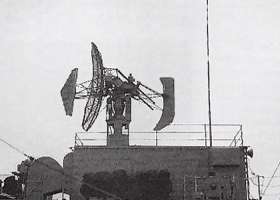AN/SPS-8
Description of the radar set, tactical-technical characteristics

Figure 1: AN/SPS-8
 Manufacturer:
Manufacturer:General Electric
| Specifications | ||
|---|---|---|
| AN/SPS-8 | AN/SPS-8A | |
| frequency: | 3 430 … 3 570 MHz
(S-Band) | |
| pulse repetition time (PRT): | ||
| pulse repetition frequency (PRF): | 500 or 1000 Hz | 450 or 700 Hz |
| pulsewidth (τ): | 1 or 2 µs | 2 µs |
| receive time: | ||
| dead time: | ||
| peak power: | 650 kW | 1 MW |
| average power: | ||
| instrumented range: | 60 NM (≙ 111 km) |
72 NM (≙ 133 km) |
| range resolution: | ||
| accuracy: | ||
| horizontal beamwidth: | 3.5° | 1.5° |
| vertical beamwidth: | 1.1° | 1.2° |
| hits per scan: | ||
| antenna rotation: | ||
| MTBCF: | ||
| MTTR: | ||
AN/SPS-8
The AN/SPS-8 and AN/SPS-8A are shipboard integrated S-Band search and height finding radar systems used for the detection and surveillance of aircraft. The AN/SPS-8 was the main early post-war height-finder. It presents target height, slant range, bearing, and beacon information. The 5 × 15 ft orange-peel shaped parabolic antenna was precisely stabilized by use of a stable element and the roll and pitch servo loops.
AN/SPS-8 used a special Robinson Scanner that scanned electically the elevation angle. The height-finders could be directed to look in a set direction, the feed nodding the beam up and down up to twenty times each minute or they could scan in azimuth as well.
The modernized AN/SPS-8A got a higher-gain astigmatic formed (nearly circular) antenna (12 × 15 ft). When the new antenna was combined with a much more powerful transmitter tube, the radar got the new designator AN/SPS-30. AN/SPS-8 and AN/SPS-30 were the standard height-finders of US carriers through the mid1960s.
Source:
- Military Standardization Handbook United States Radar Equipment Manual TM 11-487C-1 1965, p. 1220ff
- Norman Friedman: ''Fighters Over the Fleet Naval Air Defence from Biplanes to the Cold War'' Havertown Seaforth Publishing Ann Arbor, Michigan ProQuest 2016, ISBN 9781848324060 (online preview)
